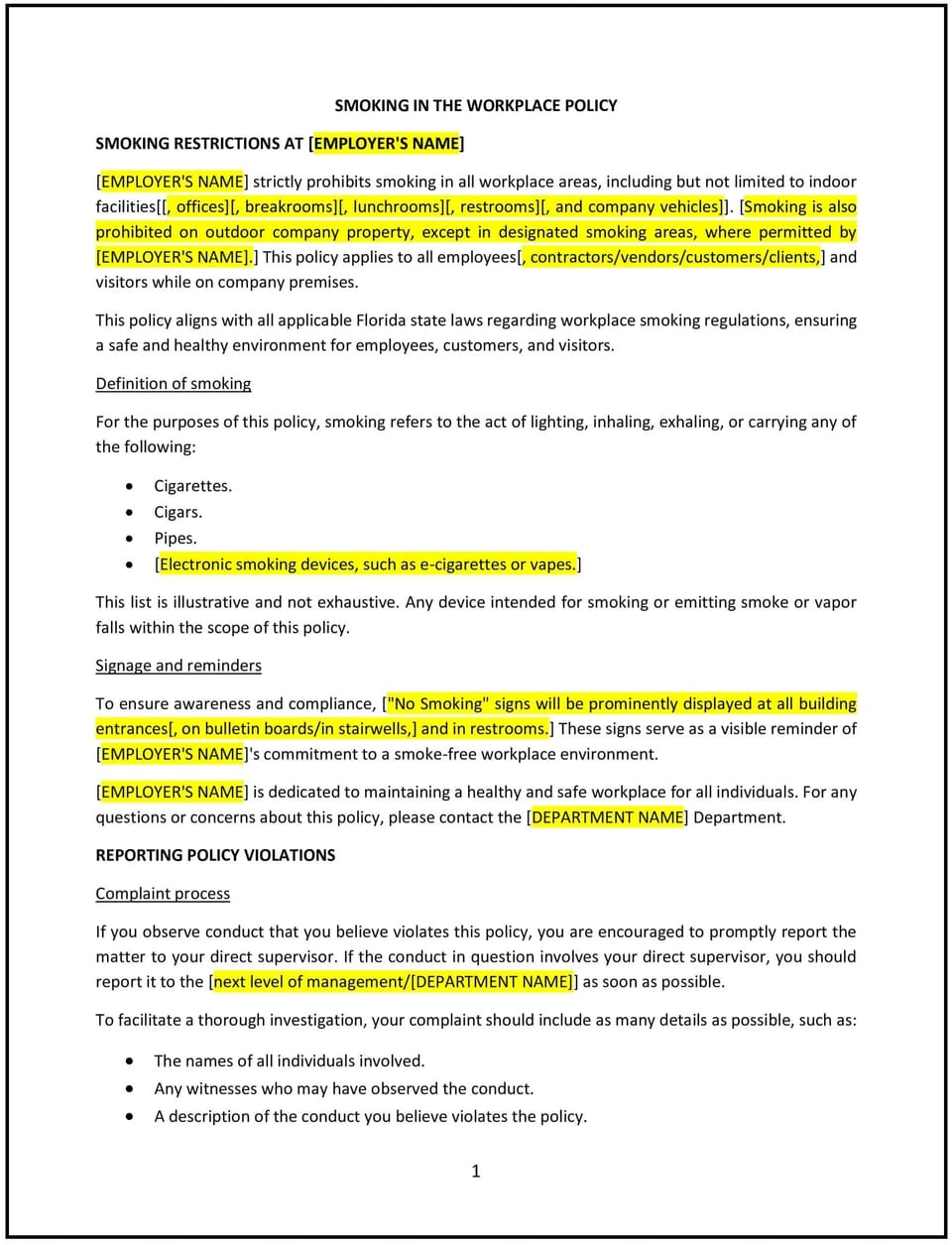Smoking in the workplace policy (Florida): Free template

Smoking in the workplace policy (Florida)
A smoking in the workplace policy helps Florida businesses establish guidelines for managing smoking activities within the workplace. This policy outlines procedures for designating smoking areas, addressing health and safety concerns, and ensuring a smoke-free environment where necessary. It is designed to promote employee well-being, reduce health risks, and provide clear expectations for managing smoking in the workplace.
By implementing this policy, businesses in Florida can demonstrate their commitment to employee health, enhance operational efficiency, and align with the state’s focus on fostering a safe and supportive workplace.
How to use this smoking in the workplace policy (Florida)
- Define smoking areas: Clearly specify where smoking is permitted, such as designated outdoor areas, and where smoking is prohibited.
- Address health and safety: Explain how the policy aims to protect all employees from secondhand smoke and promote a healthy work environment.
- Establish signage requirements: Outline how businesses should display signage to inform employees and visitors about smoking rules.
- Provide support resources: Offer information about smoking cessation programs or local resources for support.
- Communicate the policy: Share the policy with employees during onboarding and through regular communications to ensure awareness and understanding.
- Monitor adherence: Regularly review how the policy is applied and address any concerns or discrepancies promptly.
- Update the policy: Periodically assess the policy to reflect changes in workplace dynamics, legal standards, or business needs.
Benefits of using this smoking in the workplace policy (Florida)
This policy offers several advantages for Florida businesses:
- Promotes health: Clear guidelines help protect employees from secondhand smoke and promote a healthier work environment.
- Reduces risks: Defined procedures minimize the likelihood of health issues and potential legal liabilities.
- Builds trust: Demonstrates the business’s commitment to employee well-being and safety.
- Aligns with community values: Reflects Florida’s emphasis on health, safety, and mutual respect in the workplace.
- Enhances reputation: A robust policy showcases the business’s dedication to ethical practices and operational integrity.
- Improves decision-making: Helps businesses anticipate potential risks and incorporate safeguards into smoking management.
- Supports growth: A strong framework for managing smoking in the workplace fosters a culture of accountability and continuous improvement.
Tips for using this smoking in the workplace policy (Florida)
- Communicate clearly: Ensure employees understand the policy by providing written materials and discussing it during meetings or training sessions.
- Train employees: Educate staff on recognizing health risks, understanding the policy, and following procedures.
- Use signage: Place clear and visible signage in designated smoking areas and areas where smoking is prohibited.
- Stay informed: Keep up with changes in health regulations, workplace expectations, or best practices that may affect smoking policies.
- Encourage feedback: Solicit input from employees to identify areas for improvement and ensure the policy meets their needs.
- Review periodically: Assess the policy’s effectiveness and make updates as needed to reflect changes in workplace dynamics or business goals.
Q: Why should Florida businesses adopt a smoking in the workplace policy?
A: Businesses should adopt this policy to promote health, reduce risks, and demonstrate their commitment to creating a safe and supportive workplace.
Q: What types of areas should businesses designate for smoking?
A: Businesses should designate specific outdoor areas that are far enough from building entrances and air intakes to minimize exposure to secondhand smoke.
Q: Should businesses provide smoking cessation resources?
A: Businesses should offer information about smoking cessation programs or local resources for support to help employees who wish to quit smoking.
Q: How should businesses handle signage for smoking areas?
A: Businesses should place clear and visible signage in designated smoking areas and areas where smoking is prohibited to inform employees and visitors.
Q: What should businesses do if an employee smokes in a non-designated area?
A: Businesses should address violations promptly by reminding the employee of the policy and taking corrective actions, such as additional training or disciplinary measures.
Q: How can businesses ensure fairness in enforcing the policy?
A: Businesses should apply the policy consistently across all employees, ensuring that decisions are based on objective criteria and documented evidence.
Q: How often should businesses review the policy?
A: Businesses should review the policy annually or whenever there are significant changes in workplace dynamics, legal standards, or business operations.
This article contains general legal information and does not contain legal advice. Cobrief is not a law firm or a substitute for an attorney or law firm. The law is complex and changes often. For legal advice, please ask a lawyer.


